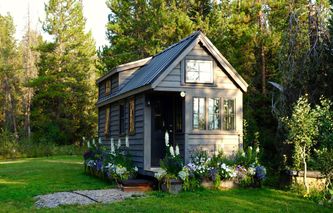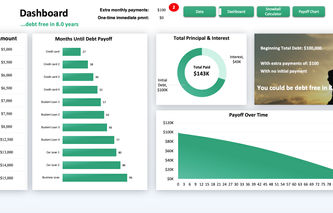My wife and I have two kids—and essentially no privacy. Even our bedroom is surrounded by the kids’ rooms, which pretty much kills any hope I have at night of… you know what I mean.
We longed for a space of our own—maybe even an entire wing if our genie-in-a-bottle wish was granted.
That’s when it hit us. We have a second story over our living area—but it doesn’t extend over the garage.
Could we build an over-the-garage addition and turn that into a master suite?
Would that be structurally possible?
What would it cost?
After a long process, we’ve got all the above questions answered—and I’m excited to share our findings with you.
But before we get into costs, I've created a home renovation tracker to help you keep all the costs in one place 👇

Perfect spreadsheet for any home renovation project 🏠
This template is:
Easily customizable for any project
It comes with examples and ready to use
It can be used in Excel or Google Sheets

More articles on real estate:
What Does a Second Story Addition Over the Garage Cost?
A second-story addition above a garage will cost about $200,000, depending on whether you want a full or more basic, partial second-floor addition. Our estimate is based on a 450-square-foot build at an average cost of roughly $450 per square foot and includes a bedroom, bathroom, and closet. (It will cost more if you live in a high-cost area or want a larger space.)
Here’s a general breakdown of the cost:
Permits/insurance/dumpsters/porta-potty: $7,000
Framing Structure: $60,000
Roof/siding: $42,000
Mechanical: $18,000
Insulation/drywall/paint/trim/cabinets/flooring: $41,000
Finishes: $6,000
Builder profit/overhead: $32,000
This $200,000 estimate was still valid in late-2022 when we checked in with our builder again.
(If you want to see the detailed quote, I’ve got it listed on Etsy as a project build tracker template. It’s only $4—cheap enough to satisfy curiosity and useful for estimating the price of your build too.)
Looking to project manage your build to save on costs?Use our free home renovation budget template.
What Does It Cost to Add a Room Above the Garage?
What if you want to build a room over the garage and not a master suite? That would be cheaper, right? Somewhat, but not worldly different.
You’ll still need to:
Demo the existing roofline.
Build the shell and insulate.
Add plywood, siding, and shingles.
Run HVAC and electrical.
Drywall, paint, and add all the finishes.
To add a bonus room above a garage, the average cost will be around $160,000. (This assumes a 400-square-foot addition at $400 per square foot.) This includes the costs of insulating, electrial work, painting, and building costs. It’slessthan the $200,000 master bedroom suite price tag, butnot as lowas one would initially think.
Cost of Building an Apartment Over the Garage
While adding a room is cheaper than a master suite addition, the cost of building an apartment, guest house, or in-law suite above the garage would be more expensive for the following reasons:
You’ll need outside access to the apartment, which will require an outer stairwell.
The apartment will need a kitchen, which means additional cupboards, appliances, and maybe even a gas line.
If you include on-suite laundry, you’ll need special electrical outlets and a washer and dryer.
Given the additional items above, I can see the price inflating to $230,000.
Have money stashed away?Why not invest it in a CD at 5% interest? Here are the top interest rates available today:
Addition Above Garage Before and After
Below is a picture of our second-story house with no living space above the garage.Beneath that is an image of the plans to add the second-story master suite.
We haven’t pulled the trigger on the addition yet, but as you can see, the builders intend to add a front peak to the garage (for a better, more updated look) and then offset the new build back from the existing second story to give the house some added dimension—great for the aesthetic.

Here’s the view from the side—

Whatever you do, don’t do the below—which is simply plunking a box on top of your garage. Sure, it might be cheap and provide the space you need, but if you ever plan on selling, you’ll have a hard time finding a buyer because of your eye-sore of an add-on.

Adding a Master Suite Above the Garage: Floor Plans and Costs
This was our intent with the build—a master bedroom over garage addition, complete with a bathroom and walk-in closet.
We went through the process I just outlined above—
We interviewed builders and found two that would tackle our job.
Based on the quotes and the interviews, we selected our builder.
After he understood what we wanted, he had a couple of floor plans drawn up for us.
Master bedroom above garage floor plans
400 sq ft master suite addition
This was the smaller, more affordable option of the two—nearly 400 square feet.

450 sq ft master suite
Then there was the slightly more luxurious and seemingly much larger space—nearly 450 square feet.

Can You Do an Over The Garage Addition?
Once we got the idea of adding a second floor to the garage, we wasted no time in contacting a builder. It turns out it’s absolutely possible to build an addition over the garage. You just need to make sure the garage structure is strong enough to support the second story.
To make sure the structure was sound, the crew—
Checked our basement block walls to see if there was any visible cracking.
Dug into the ground on the outer side of the garage to check the depth and integrity of the footings.
Viewed the studs and rafters in the garage to check if the structure was sound.
(Builders can typically fix the structural issues—but for an additional cost.)
What About Adding a Second Story to a Detached Garage?
Your setup may differ from ours. Perhaps you have a detached garage and want to build a room or apartment above it. This is possible as well.
In fact, it’seasier (which also means cheaper) than adding a room over an attached garage since you don’t need to tie into any of the existing second-story construction, HVAC, plumbing, or electricity.
If you want to add a room above a detached garage,you just need to worry about the foundation’s integrity. That’s it.
Benefits of Adding a Second Story to Your Garage
You want more space in your house, but should you build out, up, or construct a separate building in the backyard?
Below are the main benefits of building on top of the garage—
You need an at-home office
I work from home. My “office” is still in our upstairs bedroom. It works, but it’s not ideal. We considered finishing a portion of the basement for an office, but being under the main level means noise—foot thumping and the occasional shrills from the children. Being upstairs is ideal for an office space. We'd free up a bedroom that could easily become a dedicated office by building above the garage.
Avoid using up yard space
Very few people live in a rural setting these days—which means limited side-to-side space for expanding your home. Chances are, you can’t build out—so the next ideal option is to build up.
Soundproofed space
Building above the garage is appealing because it’s usually the quietest space in the entire house. There’s no noise traveling up into your new build area—just the occasional garage door hum. And, if any noise (ahem…) comes from the room above the garage, the odds of your children being scarred for life are greatly reduced.
Increased visual appeal
If done right, adding a living space above the garage can improve the look of your house. You’re giving yourself room to roam, and your house looks better. That’s a win for you now and in the future, should you ever decide to sell.
Increased value of your home
You probably saw this coming. If your house looks better and has more space, it will be worth more. It’s not the best thing you can do to add value to your home, but it certainly does still help.
Could save on costs
You’re working overtop an unfinished space when you build above the garage. The builders won’t need to be as cautious about what they’re doing, and finishing the garage space will cost less than reconstructing the kitchen after ripping off the ceiling to build above it. If you’re going to build up, plan to build over the garage if possible.
Could produce an additional income
Rentals are tough to come by—so costs are up. Maybe you’re considering building an apartment above the garage for additional income. It’s certainly not a bad idea. If you could build an above-garage apartment for $100,000 and earn yourself $20,000 a year in rent, the project would pay for itself in just five years (plus, you’ve still got the added value of that space that you’d earn when you sell the house).
What Are The Challenges of Building a Room Over a Garage?
It can sound like a dream, but adding a room above the garage isn’t all sunshine and rainbows. Some challenges can present themselves along the way—
Foundation Issues
We already discussed the importance of the foundation above the garage build. If your foundation has issues, but you still want to move forward with the addition, it will cost you more. And since the foundation isn’t easy to get to, it could cost tens of thousands of dollars to remedy.
Heating, Cooling, Electrical, and Plumbing
This is one I didn’t fully consider. Sure, you’re going to need to have heat, air conditioning, plumbing, and electrical into the new addition, and that’s going to cost money, but there are two other factors I didn’t think about—
1) How to route everything to the new room above the garage
You might have a standard furnace with ductwork.
Where are you going to route the new ductwork for your addition?
Can you use the existing chase?
Or will you need to create a new one?
The same question is relevant for plumbing. If you have a bathroom in your new space, you’ll need to route some new piping through your home. If you’re creating new chases, that means more construction, more drywall, and more finish work. That all takes time and costs additional dollars.
2) Can the current systems support the increased load?
How old is your existing breaker box? Will you have enough additional amperage in that box to power an entire master suite or apartment?
What about your furnace or boiler?
Your A/C unit?
What about your water heater?
Updating just one of these systems could be a five-figure cost.
Working around previous remodels
Have you done remodels before? If they’re near the garage, your addition might become a bit more challenging. Also, if you’re running any venting, electrical, or plumbing over your garage, these likely need to be moved before construction starts.
Architectural features/styles
Each house is unique—they have their own style and features. And if you do an addition, you want that addition to match and appear natural to the house. The last thing you want is to put a ton of money, time, and energy into an addition only to have someone point at it from the curb and say, “Yikes, that’s an obvious add-on!” The greater the style of your house, the more challenging it might be to match.
Will the addition fit naturally with your existing structure?
Adding a structure above the garage may seem easy, but how do you plan to access it from inside the house? Will you add new stairs—or can you use the old ones?
This was a tough one for us. Our stairs lined the wall adjoining the garage and made a turn at the top before getting to the second-floor level. If we made a master suite in the opposite direction, the hallway from the existing bedrooms would step down—and then back up into the master.
Therewasn’t an easy solution to correct this. You might have a similar structural issue that makes the house quirky or costs you a bunch more money to make it more seamless.
Additional costs to keep the above garage addition safe from fire
The building code is pretty relaxed when there’s nothing above the garage. However, if you add living space over the garage, you’ll need at least ⅝” Type X gypsum board on the ceiling and ½” drywall on the walls. Our garage walls and ceiling were mostly paper-thin paneling—which obviously wasn’t compliant with the minimum drywall code.
Looking to do other renovations? Check out these projects, plans, and costs:
What’s the Process for an Addition Above the Garage?
If you’re just dipping your toes into this above garage building project, you’re probably wondering what it all entails—where do you start, and how do you get your construction project underway?
Interview builders
First, you’ve got to find a builder that will tackle your second-story garage addition (which isn’t as easy as you might think). The easy money for a builder is in constructing complete houses—not working on remodel projects here and there. And one of the most complex remodels is adding a second story over the garage—so be ready to hit some roadblocks here. We had to go through nearly ten builders to get one or two that would consider taking on our project.
When you find a few builders that will consider your project, take the time to interview them and see if they are the best person for the job. (The last thing you want is for a contractor to rip a hole in your roof only to find out they’re incompetent in all the remaining steps of the build.)
Get high-level quotes
To get a ballpark quote, let your prospective builders know how many square feet you’d like to add. They may not like it—but if you press them, they should be able to give you a rough cost of your addition based solely on a per-square-foot rate.
Get plans drawn up—decide on one
The next step is to carry your vague vision into actual design plans. Between your contractor and their architect, they’ll put your vision into a few different CAD drawings so you can see various floor plans and sizes (at varying costs). Either you’ll fall in love with one of them and select it, or use the drafts to create new plans.
Get a detailed quote from your builder—then add or subtract items
With the blueprints of your new second-story garage addition, your builder will put together a detailed quote for your entire build. This will include items from the porta-potty in your backyard to the $20,000 siding costs of re-wrapping your entire upper level (I may still be bitter about this one).
Do the pre-work
It’s time to rip off the garage roof and build, right? Wrong. Now is the time to get all the pre-work done.
This was our to-do list:
Tear down and cap the unused chimney (it was that or build it up above the new addition, which would have cost more than $15,000).
Get the outside electrical line buried and off the roof.
Have electricians update our breaker box—from 100 amps to 200 amps.
Replace our boiler system (it was 50 years old and would not handle a new zone).
Tear off the garage paneling to expose the studs and ceiling joists.
Your list will differ—but rest assured, you’ll have a list.
Schedule the build
Time to schedule the start date. This is super exciting, but prepare yourself for construction life.
Live in chaos for months
I can picture it now—
A gaping hole in your garage ceiling.
Rainwater somehow leaking into your house.
And the sound of nail guns 24/7 for months to come.
Living in a construction zone isn’t for the faint of heart. Stress levels will be up (along with petty arguments), and tears will be shed. Just expect it. Oh, and that projected end date that your contractor gave you? Plan on it taking a month longer than that. (It always does.)
And, perhaps plan a getaway trip a week or two before the project even starts. You’re going to need it.
How to Finance an Above Garage Addition
You’re set on it. You want to put a 2nd-floor addition over your garage. Now what?
Since most people don’t have $200,000 chilling in the bank, you’ll probably need to finance a portion of the build. What are your options?
Home equity loan
Home equity line of credit
Cash-out refinance loan
If you’ve lived in your house a few years, you likely have some equity in it—due to its increased value and because you’ve paid down the principle. With a cash-out refinance loan, you’re essentially taking out a new mortgage that’s larger than your current one and pocketing the difference.
Cost
2% to 5% closing costs, and a new mortgage payoff rate (which is likely higher than your current rate).
Renovation loan
A renovation loan can mean many things, but if you’re looking to add a master bedroom above the garage, chances are you’ve been living in your home for a while. If that’s the case, a renovation loan will be much like a personal loan. To get a personal loan, a lender won’t ask you about your house—they’ll instead consider your credentials, like your credit score, income, and any other debt you may have.
Cost
Rates are typically between 8% and 24%, depending on your credit score.
Home equity loan
Commonly referred to as a second mortgage, the home equity loan allows you to take out a second loan on your house. This is a separate mortgage from your first one—and comes with its own monthly payment.
To secure a home equity loan, you’ll need:
Enough equity in your home to support the loan.
A low debt-to-income ratio (general rule of thumb is that your debt is less than 43% of your total monthly income).
A good credit history (~700 or above)
Cost
Closing costs—2% to 5% of the loan amount, plus the second mortgage loan rate.
Home equity line of credit
A home equity line of credit (HELOC) works differently than a home equity loan. Instead of the bank loaning you a lump sum amount of money, the HELOC is an open line of credit—and it’s your choice of when and how much to borrow against it.
Let’s say your home is worth $300,000. You owe $150,000 on it—so your equity is $150,000. Perhaps you’re considering a remodel or the new build above your garage, but you’re just not sure.
To prepare for a construction project, you head to the bank and sign up for a $100,000 HELOC. You’ll likely pay 2% to 5% in closing costs to set up the HELOC ($2,000 to $5,000 using our example), and then you’ll owe interest on any loan you withdraw from your HELOC.
Cost
Closing costs—2% to 5% of the HELOC, then the loan rate of the amount you borrow.
(Check out our free mortgage payoff calculator and other personal finance products for more.)
What is the best option to finance a second-story addition?
I’m a big fan of simplicity. It’s better for my brain and stress level—and it usually costs me less money down the road (since there are fewer balls to keep in the air).
If it were me, I’d choose one of the options below:
Save up cash for the entire build (I know, I know—but it often is the best option).
Save up enough money to build the shell of the structure—then, keep saving until you have enough to purchase the next phase of the project. (Follow this process until it’s complete.)
Save up a decent amount of cash (50% or more), and then fund the rest of it with a personal loan—one that you’re sure you can pay off in just a year or two.
Alternatives to an Over the Garage Addition
What if you decide that an addition above the garage just won’t work? What could you do instead?
Backyard home
Technically called accessory dwelling units (ADUs), the backyard home might be a great alternative to building over the garage. Essentially, it’s a step above a tiny house—complete with a sleeping area, kitchen, and bathroom.
Since adding room above the garage can run $200,000+, this might be a great option to add more space that costs the same amount or less. If you’re looking for secluded office space, it’s a definite possibility.
Garage revamp
How much do you use your actual garage? Do you park your cars in it, or has it become a big storage unit for your junk? What if you transformed it into a livable space? It would be far simpler than adding above it—and way cheaper to boot.
Basement apartment
Is your basement unfinished? What if you added walls and carpet down there instead? Again, this will be easier and cheaper than tearing your roof off and living in a construction zone for an entire summer.
Attic apartment
If you have unused attic space, perhaps you could turn it into a finished room.
House bump-out
If the numbers aren’t working with your above garage addition, get the main-level bump-out quoted. Sometimes it’s easier to lay flat concrete than address old footings underneath the garage.
Takeaways
To sum it all up—
Itis possible to put an addition over the garage as long as the footings and garage framing are still structurally sound.
Benefits include:
You don’t need to use up precious yard space.
It’s a great soundproof area above the garage.
Can add to your home’s aesthetic.
Adds value to your home.
More cost-effective than building over a finished space.
It could be a money-maker if you rent the space out.
Challenges include:
Potential foundation issues.
Working around previous remodels.
Figuring out how to route HVAC, electrical, and plumbing.
Architectural look—inside and out.
Additional costs to make the space fire-resistant from the garage.
The process is like a house build since it’s a major renovation.
The above garage addition cost is roughly $200,000, give or take—depending on what you want to put in the space.
There are multiple ways to finance the project—including a renovation loan, a personal loan, a home equity loan, or a HELOC.
If it just isn’t working out, there are alternative options—like a backyard house, a garage renovation, an attic remodel, a basement remodel, or building out instead of up.

.jpg)



